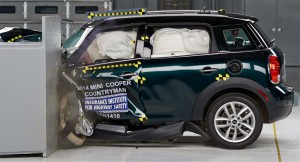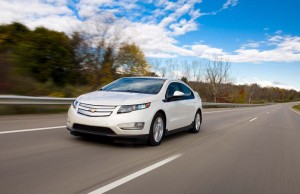
The 2014 Mini Countryman was the only vehicle to earn a "good" rating in the latest IIHS small car crash tests.
For those worried about the safety of today’s small cars, the latest round of crash tests conducted by the Insurance Institute for Highway Safety didn’t provide much good news.
Out of an even dozen vehicles included in the test, only the Mini Countryman earned a “good” rating. And among the plug-based vehicles included in the tests for the first time, only the Chevrolet Volt plug-in hybrid managed to eke out an “acceptable” rating – while also earning a Top Safety Pick+ award.
“The Mini Cooper Countryman gave a solid performance,” says Joe Nolan, the Institute’s senior vice president for vehicle research. “The Countryman’s safety cage held up reasonably well. The safety belts and airbags worked together to control the test dummy’s movement, and injury measures indicate a low risk of any significant injuries in a real-world crash this severe.”
The IIHS has become something of the gold standard for car buyers concerned about safety, the industry-funded group subjecting vehicles to even more challenging tests than are mandated by law. That includes the recently added small overlap test designed to simulate in a large number of real-world crashes, when vehicles strike an object like a utility pole, or the corner of an oncoming vehicle.
That has been the downfall of a number of recent models, as it often results in serious penetration of the passenger compartment that would, on the road, lead to serious injuries or fatalities.
(New, high-tech safety features click with car buyers. Click Here for the full story.)
“Collapse of the occupant compartment is the downfall for four small cars in this group, including the Fiat 500L, Mazda5, Nissan Juke and Nissan Leaf,” said Nolan. “A sturdy occupant compartment allows the restraint systems to do their job, absorbing energy and controlling occupant motion.”
All four of those vehicles earned “poor” ratings, while the Hyundai Veloster and Scion xB were rated “marginal.” Among those in the “acceptable” category were the Volt, as well as the Ford C-Max Hybrid, Mitsubishi Lancer, Scion FR-S and Subaru BRZ, the latter two based on the same sports car platform.
The latest tests saw the Volt and Leaf subject to the small overlap test for the first time. The test has proven especially challenging for small cars, but even a number of larger vehicles have failed since the test was introduced in 2012. A number of makers have responded by redesigning the front of their vehicles, such as the 2015 Toyota Camry and Corolla sedans.
(American motorists want self-driving cars, says new study. Click Here for more.)
The IIHS has traditionally given out Top Safety Pick awards but has expanded the list of factors needed to qualify for a “plus” rating. To get that award, a vehicle must not only score well in various crash tests but also include an active front crash protection system. The Chevy Volt was the only one of the dozen small cars to offer that feature.
“Vehicle and customer safety is of utmost concern to us,” said Jeff Boyer, the recently appointed GM safety czar. “GM is committed to outstanding results from all of the safety tests we are a part of — the recognition of the Chevrolet Volt as a Top Safety Pick+ vehicle is a testament to that.”
A statement from the IIHS, meanwhile, noted that, “The C-Max Hybrid, Countryman, Mitsubishi Lancer and Scion FR-S and its twin the Subaru BRZ qualify for Top Safety Pick, the Institute’s second-highest award.”
(Click Here to learn a dozen ways to help keep your car from being stolen.)
Previous testing earned five other current models Top Safety Pick+ ratings: the Mazda3 sedan, the Mazda3 hatchback, the Honda Civic sedan, the Volkswagen Golf and the VW GTI. All are 2014s except for the new VW models which are badged 2015s.
Along with the four new models added to the list there are now an even dozen with Top Safety Pick ratings. The full list can be found at www.IIHS.org.


So much for employing h1b visa “experts”.